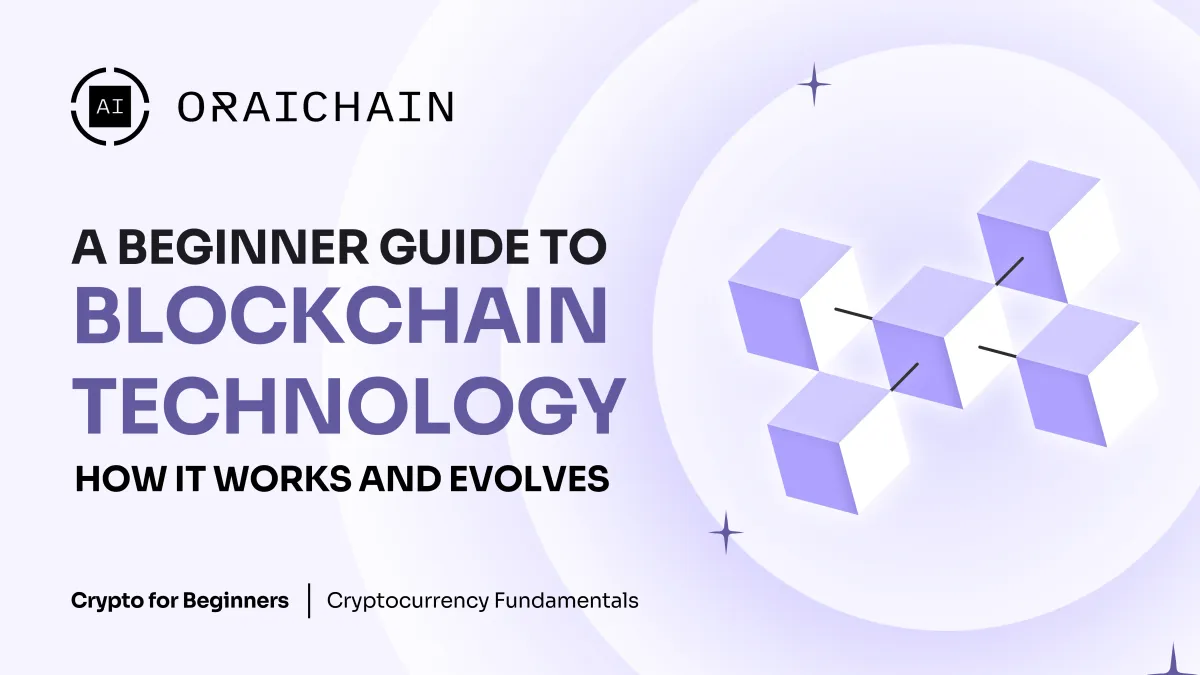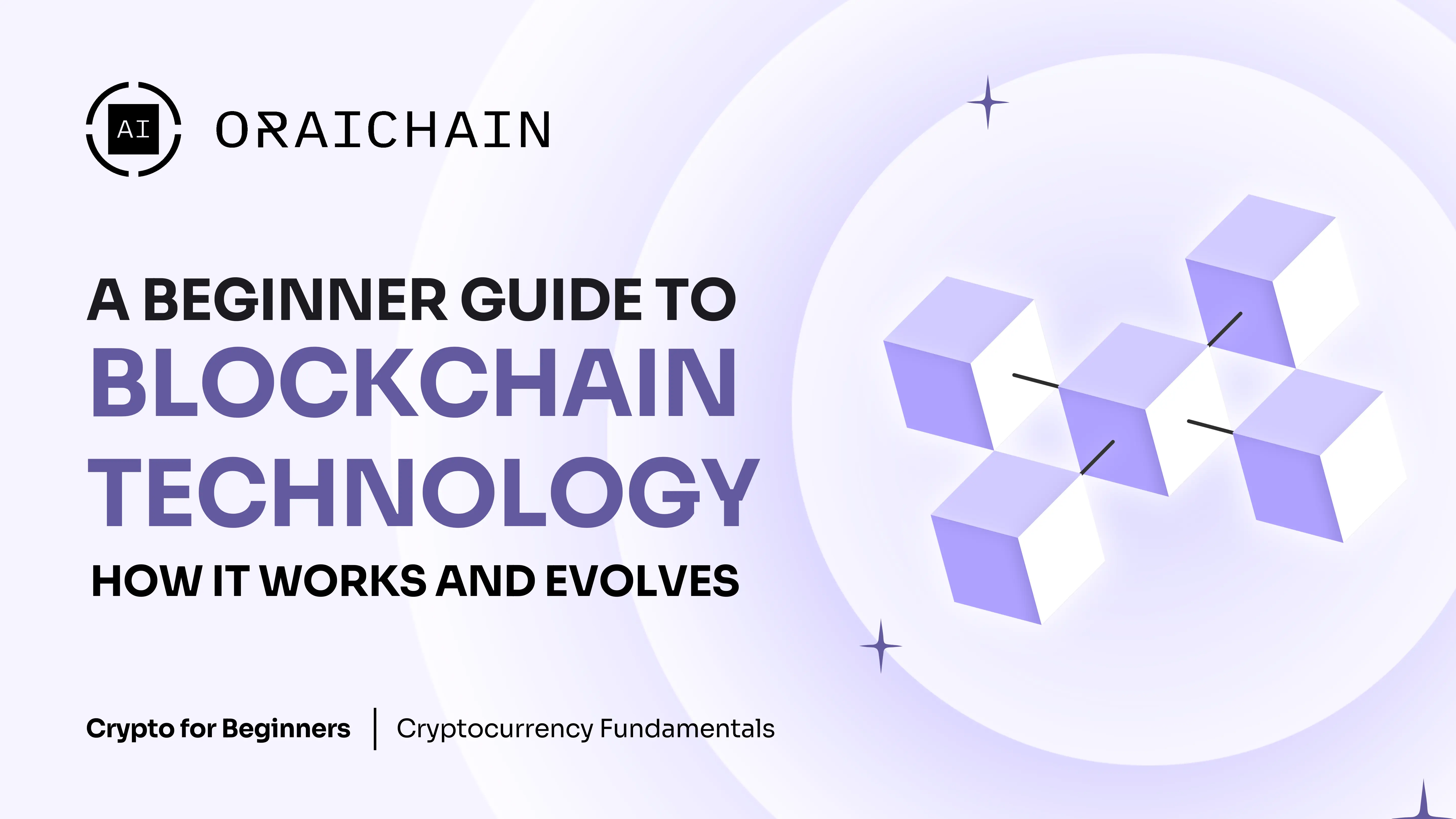A Beginners' Guide to Blockchain Technology: How it works and evolves?

Newcomers exploring blockchain technology often discover it as an exciting and rewarding field filled with intriguing challenges. This section is the perfect starting point for you to embark on your journey of learning about this technology. Blockchain doesn't have to be scary, and we're here to simplify blockchain fundamentals and its evolution.

Basics of Blockchain Technology
What is Blockchain?
Let's decode the word “blockchain". Blockchain consists of “block" and “chain". Block is where your data is stored in a secure, transparent, and immutable manner. Blocks are connected, in which data is linked to the previous ones, forming a chain.
With blockchain, there are only decentralized databases, which means distributing control and decision-making across many computers in a network, rather than having one central authority. The data is chronologically consistent because you cannot delete or modify the chain without consensus from the network.
One might wonder about the types of data recorded in these blocks. Various kinds of data can be documented; however, to simplify, given the widespread adoption of blockchain technology in cryptocurrency and digital finance, the most commonly recognized data type is 'transactions'.
At this point, let's say blockchain technology is a decentralized and distributed ledger that records transactions across multiple computers in a secure, transparent, and immutable manner.
An Overview of how blockchain technology works
To delve into the mechanics of blockchain technology, it is essential to address the question: "What entities are responsible for the functioning of blockchain?" The answer lies in two primary components: miners and nodes. These elements play crucial roles in maintaining and facilitating the operations of the blockchain network.
Miners: Real world miners mine rock to find precious ores and receive iron or gold as their reward. The same process happens in the cryptocurrency world.
Nodes: Unlike miners, which are block creators, full nodes act as a sort of librarian for the “blockchain library” and they do not receive direct rewards for their work.
Nodes are individual computers that participate in the network by validating and broadcasting transactions to the entire network, storing a copy of the blockchain to ensure the network’s decentralization and security.
In short, while all miners are nodes, not all nodes are miners. Nodes serve to maintain the blockchain network, while miners are responsible for validating and adding transactions to the blockchain.
The Evolution of Blockchain Technology
Understanding the significant evolution of blockchain technology from its inception is essential for gaining comprehensive insights. This understanding can be facilitated through a concise three-minute read provided below.
- Blockchain 1.0: The Emergence of Cryptocurrencies
Blockchain 1.0, also known as the first generation of blockchain technology, has been rapidly developing since Satoshi Nakamoto introduced Bitcoin in 2008 as a blockchain-based digital currency.
Following Bitcoin, developers began to explore the possibilities of a technology called distributed ledger technology (DLT) in the finance world. Bitcoin and this new technology inspired the gradual creation of many other Blockchain 1.0 projects, marking the emerging era of cryptocurrencies.
For the first time in the world’s financial history, monetary transactions became completely decentralized. It was a significant step forward in the way we handle money.
- Blockchain 2.0: Smart Contracts
Blockchain 2.0 represents the era of smart contracts that helped Blockchain to outgrow its original functionality of powering cryptocurrencies.
Smart contracts, enabled by blockchain technology, are self-executing agreements written directly into code, revolutionizing the way agreements are made and transactions are conducted.
This advancement enables a wide range of applications, including decentralized finance (DeFi), supply chain management, voting systems, digital identity, etc. while eliminating the need for intermediaries, reducing transaction costs, and increasing the efficiency and security of transactions.
In 2013, Ethereum was introduced as a 2nd-generation public blockchain. Like Bitcoin, Ethereum adapts the PoW consensus method, requiring heavy mining hardware and significant resources, gradually becoming the go-to Blockchain for enterprises across industries, especially supply chain, logistics, and cross border payments.
- Blockchain 3.0: Decentralized Applications (Dapps)
Blockchain 3.0 has been all about the rise of Dapps! With a user-friendly frontend interface, dApps support various powerful blockchain use-cases like DeFi platforms, crypto loan platforms, NFT marketplaces, P2P lending, and others.
Ethereum kickstarted the dApp development and DeFi, and this concept found new dimensions with the introduction of 3rd generation dApp-focused blockchains like Cardano, Solana, IOTA, Nano, XDC, and many more.
These new entrants are improving blockchain adoption at the mass level by addressing the shortcomings in the second-generation blockchains. Powered by new consensus mechanisms, 3rd generation blockchain protocols are focusing on areas like speed, security, scalability, interoperability, and environmental friendliness.
- Blockchain 4.0: The future blockchain technology
Blockchain 4.0 is anticipated to represent a significant leap forward in the integration of blockchain technology into real-life business scenarios, especially expected to bring about significant advancements in web3, metaverse, and their influence on Industry 4.0.
Moving away from the centralized models of Web 2.0, Web3 aims to give users more control over their data and digital interactions. With Blockchain 4.0, we can expect further Web3 developments, making them more suitable for widespread adoption and integration into various industries.
Metaverse, on the other hand, represents a digital universe where users can interact with each other and digital objects in real-time. Blockchain technology plays a crucial role in metaverse development by providing secure and decentralized infrastructure for virtual asset ownership, digital identity, and value exchange.
The influence of web3 and metaverse on Industry 4.0 is significant and potential to revolutionize various aspects including supply chain management, digital asset tracking, remote collaboration, and immersive training simulations.
By leveraging blockchain technology and its capabilities, industries can enhance efficiency, transparency, and trust in their operations, leading to a more interconnected and digitized industrial landscape.
Blockchain Solutions for Enterprise and End User
Blockchain technology has evolved from a niche concept to a powerful tool for enterprises and end users alike. This article explores practical blockchain solutions that are transforming industries and everyday life.
Understanding Blockchain: Key Facts and Applications
Blockchain is a distributed ledger technology that records transactions across a network of computers. Here are essential blockchain facts:
- Transactions are grouped into blocks
- Each block links to the previous one, forming a chain
- Data is immutable and transparent
- No central authority controls the network
Businesses and individuals use blockchain for various purposes:
- Secure transactions: Cryptocurrencies like Bitcoin use blockchain for peer-to-peer payments.
- Supply chain management: Companies track products from manufacture to delivery.
- Identity verification: Users control their personal data securely.
- Smart contracts: Self-executing agreements automate processes.
Blockchain companies are developing solutions across industries. From finance to healthcare, these innovations are reshaping how we interact with data and conduct business.
NFTs and Digital Ownership
Non-fungible tokens (NFTs) represent a significant development in blockchain technology. NFTs blockchain applications include:
- Digital art ownership
- Collectibles and virtual real estate
- Event tickets and memberships
- Intellectual property rights
NFTs provide verifiable ownership of digital assets. This technology enables creators to monetize their work directly and allows collectors to prove the authenticity of their purchases.
To create an NFT:
- Choose a blockchain platform (e.g., Ethereum, Solana)
- Set up a digital wallet
- Connect to an NFT marketplace
- Upload your digital asset
- Set pricing and royalty terms
- List your NFT for sale
NFTs have opened new opportunities for artists, musicians, and content creators to engage with their audience and monetize their work in innovative ways.
Enterprise Blockchain Solutions: Transforming Business Operations
Enterprises are adopting blockchain to enhance efficiency, security, and transparency. Here's how different sectors are implementing blockchain solutions:
Finance and Banking
Banks and financial institutions use blockchain for:
- Cross-border payments
- Trade finance
- Know Your Customer (KYC) processes
- Fraud prevention
Implementing blockchain in finance:
- Identify pain points in current processes
- Choose a suitable blockchain platform
- Develop smart contracts for automation
- Integrate with existing systems
- Train staff on new procedures
- Monitor and optimize performance
Blockchain transactions in finance reduce costs and processing times while increasing security and transparency.
Supply Chain Management
Blockchain improves supply chain visibility and traceability:
- Product origin verification
- Real-time tracking
- Inventory management
- Supplier payments
To implement blockchain in supply chains:
- Map your supply chain network
- Select a blockchain platform
- Develop tracking and verification protocols
- Onboard suppliers and partners
- Implement IoT devices for data collection
- Train staff and partners on the new system
This approach enhances efficiency and builds trust among stakeholders.
Healthcare
Blockchain in healthcare focuses on:
- Secure patient data sharing
- Drug traceability
- Clinical trial management
- Insurance claim processing
Implementing blockchain in healthcare:
- Identify data sharing challenges
- Choose a HIPAA-compliant blockchain solution
- Develop protocols for data access and sharing
- Integrate with existing electronic health records (EHR) systems
- Train healthcare providers on the new system
- Monitor data integrity and system performance
These solutions improve patient care and streamline administrative processes.
End User Blockchain Applications: Empowering Individuals
Blockchain technology is not just for enterprises. End users benefit from various blockchain applications in their daily lives.
Decentralized Finance (DeFi)
DeFi platforms offer financial services without intermediaries:
- Lending and borrowing
- Yield farming
- Decentralized exchanges
- Stablecoins
To participate in DeFi:
- Set up a cryptocurrency wallet
- Acquire cryptocurrencies or stablecoins
- Connect your wallet to a DeFi platform
- Explore different protocols and their offerings
- Start with small amounts to understand the risks
- Monitor your investments regularly
DeFi provides access to financial services for those excluded from traditional banking systems.
Digital Identity Management
Blockchain enables self-sovereign identity:
- Control over personal data
- Secure identity verification
- Reduced identity theft risk
Steps to manage your digital identity on blockchain:
- Choose a blockchain-based identity platform
- Create your digital identity
- Add and verify your credentials
- Control access to your data
- Use your digital identity for various services
- Keep your private keys secure
This approach gives users more control over their personal information and how it's shared.
Blockchain Voting: Enhancing Democratic Processes
Blockchain voting systems aim to increase transparency and security in elections. Here's how it works:
- Voter registration on a blockchain platform
- Secure authentication using cryptographic keys
- Casting votes as blockchain transactions
- Real-time vote counting and verification
- Immutable record of all votes cast
Implementing blockchain voting:
- Develop a secure blockchain voting platform
- Conduct extensive testing and security audits
- Educate voters on the new system
- Provide multiple voting options (in-person and remote)
- Ensure accessibility for all eligible voters
- Implement robust voter support services
While promising, blockchain voting faces challenges in scalability and voter privacy that need addressing before widespread adoption.
The Future of Blockchain: Emerging Trends and Opportunities
As blockchain technology matures, new trends are emerging:
- Interoperability between different blockchains
- Integration with artificial intelligence and IoT
- Increased focus on sustainability and energy efficiency
- Regulatory frameworks for blockchain applications
For blockchain startups and established companies, these trends present opportunities to innovate and create value.
To stay ahead in the blockchain space:
- Keep up with the latest research and developments
- Participate in blockchain communities and forums
- Experiment with different blockchain platforms
- Collaborate with other companies and startups
- Invest in continuous learning and skill development
- Consider the ethical implications of blockchain applications
By focusing on solving real-world problems, blockchain solutions will continue to drive innovation across industries.
In conclusion, blockchain technology offers transformative solutions for both enterprises and end users. From enhancing business operations to empowering individuals with greater control over their data and finances, the potential applications are vast. As the technology evolves, we can expect to see even more innovative uses of blockchain that will shape our digital future.
To wrap up, blockchain technology has come a long way, evolving to the dynamic Blockchain 4.0 era. For newcomers, make sure to stay in the loop on Oraichain Labs' Crypto for beginners series. There's a whole universe of potential waiting to be unlocked through blockchain technology!
Explore beginner-level crypto knowledge at orai.io to confidently start your journey with expertise.



